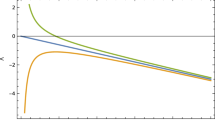Abstract
This paper investigates the existence of Noether symmetries of isotropic universe model in \(f(R,T)\) gravity admitting minimal coupling of matter and scalar fields. The scalar field incorporates two dark energy models such as quintessence and phantom models. We determine symmetry generators and corresponding conserved quantities for two particular \(f(R,T)\) models. We also evaluate exact solutions and investigate their physical behavior via different cosmological parameters. For the first model, the graphical behavior of these parameters indicate consistency with recent observations representing accelerated expansion of the universe. For the second model, these parameters identify a transition form accelerated to decelerated expansion of the universe. The potential function is found to be constant for the first model while it becomes \(V(\phi )\approx \phi ^{2}\) for the second model. We conclude that the Noether symmetry generators and corresponding conserved quantities appear in all cases.









Similar content being viewed by others
References
Bamba, K., Nojiri, S., Odintsov, S.D.: J. Cosmol. Astropart. Phys. 0810, 045 (2008)
Bamba, K., Capozziello, S., Nojiri, S., Odintsov, S.D.: Astrophys. Space Sci. 342, 155 (2012)
Capozziello, S., de Ritis, R.: Class. Quantum Gravity 11, 107 (1994)
Capozziello, S., Stabile, A., Troisi, A.: Class. Quantum Gravity 24, 2153 (2007)
Capozziello, S., De Laurentis, M., Odintsov, S.D.: Eur. Phys. J. C 72, 2068 (2012)
Carroll, S.M., Hoffman, M., Trodden, M.: Phys. Rev. D 68, 023509 (2003)
Copeland, E.J., Sami, M., Tsujikawa, S.: Int. J. Mod. Phys. D 15, 1753 (2006)
de Benedictis, A., Das, A., Kloster, S.: Gen. Relativ. Gravit. 36, 2481 (2004)
de Felice, A., Tsujikawa, S.: Living Rev. Relativ. 13, 3 (2010)
Elizalde, E., Nojiri, S., Odintsov, S.D.: Phys. Rev. D 70, 043539 (2004)
Hanc, J., Tuleja, S., Hancova, M.: Am. J. Phys. 72, 428 (2004)
Harko, T., Lake, M.J.: Eur. Phys. J. C 75, 60 (2015)
Harko, T., Lobo, F.S.N.: Galaxies 2, 410 (2014)
Harko, T., Lobo, F.S.N., Nojiri, S., Odintsov, S.D.: Phys. Rev. D 84, 024020 (2011)
Hussain, I., Jamil, M., Mahomed, F.M.: Astrophys. Space Sci. 337, 373 (2012)
Jamil, M., Mahomed, F.M., Momeni, D.: Phys. Lett. B 702, 315 (2011)
Jamil, M., Momeni, D., Myrzakulov, R.: Eur. Phys. J. C 72, 2137 (2012)
Mamon, A.A., Das, S.: Eur. Phys. J. C 75, 244 (2015)
Mamon, A.A., Das, S.: Eur. Phys. J. C 76, 135 (2016)
Momeni, D., Myrzakulov, R., Güdekli, E.: Int. J. Geom. Methods Mod. Phys. 12, 1550101 (2015)
Nojiri, S., Odintsov, S.D.: Phys. Lett. B 599, 137 (2004a)
Nojiri, S., Odintsov, S.D.: Phys. Rev. D 70, 103522 (2004b)
Nojiri, S., Odintsov, S.D.: Phys. Lett. B 595, 1 (2004c)
Nojiri, S., Odintsov, S.D.: Phys. Lett. B 686, 44 (2010)
Nojiri, S., Odintsov, S.D.: Phys. Rep. 505, 59 (2011)
Shamir, M.F.: Eur. Phys. J. C 75, 354 (2015)
Shamir, M.F., Raza, Z.: Astrophys. Space Sci. 356, 111 (2015)
Shamir, M.F., Jhangeer, A., Bhatti, A.A.: Chin. Phys. Lett. 29, 080402 (2012)
Sharif, M., Fatima, I.: J. Exp. Theor. Phys. 122, 104 (2016)
Sharif, M., Nawazish, I.: J. Exp. Theor. Phys. 120, 49 (2014)
Sharif, M., Nawazish, I.: Gen. Relativ. Gravit. 49, 76 (2017a)
Sharif, M., Nawazish, I.: Eur. Phys. J. C 77, 198 (2017b)
Sharif, M., Nawazish, I.: Mod. Phys. Lett. A 32, 1750136 (2017c)
Sharif, M., Shafique, I.: Phys. Rev. D 90, 084033 (2014)
Sharif, M., Zubair, M.: J. Cosmol. Astropart. Phys. 03, 028 (2012)
Sharif, M., Zubair, M.: J. Exp. Theor. Phys. 117, 248 (2013a)
Sharif, M., Zubair, M.: J. Phys. Soc. Jpn. 82, 064001 (2013b)
Sharif, M., Zubair, M.: J. Phys. Soc. Jpn. 82, 014002 (2013c)
Sharif, M., Zubair, M.: Astrophys. Space Sci. 349, 52 (2014a)
Sharif, M., Zubair, M.: Gen. Relativ. Gravit. 46, 1723 (2014b)
Sharif, M., Zubair, M.: Astrophys. Space Sci. 349, 457 (2014c)
Sotiriou, T.P., Faraoni, V.: Rev. Mod. Phys. 82, 451 (2010)
Vakili, B.: Phys. Lett. B 664, 16 (2008)
Zhang, Y., Gong, Y.G., Zhu, Z.H.: Phys. Lett. B 688, 13 (2010)
Acknowledgement
This work has been supported by the Pakistan Academy of Sciences Project.
Author information
Authors and Affiliations
Corresponding author
Rights and permissions
About this article
Cite this article
Sharif, M., Nawazish, I. Scalar field cosmology in \(f(R,T)\) gravity via Noether symmetry. Astrophys Space Sci 363, 67 (2018). https://doi.org/10.1007/s10509-018-3291-4
Received:
Accepted:
Published:
DOI: https://doi.org/10.1007/s10509-018-3291-4




